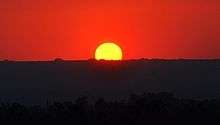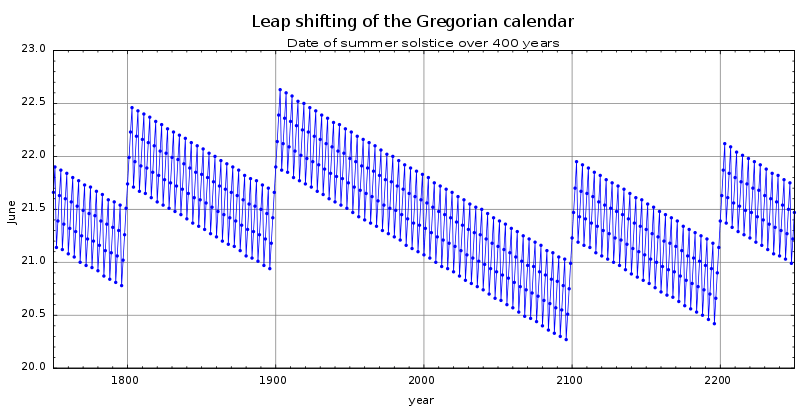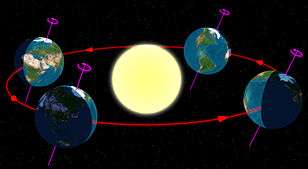Summer solstice
| event | equinox | solstice | equinox | solstice | ||||
|---|---|---|---|---|---|---|---|---|
| month | March | June | September | December | ||||
| year | ||||||||
| day | time | day | time | day | time | day | time | |
| 2013 | 20 | 11:02 | 21 | 05:04 | 22 | 20:44 | 21 | 17:11 |
| 2014 | 20 | 16:57 | 21 | 10:51 | 23 | 02:29 | 21 | 23:03 |
| 2015 | 20 | 22:45 | 21 | 16:38 | 23 | 08:21 | 22 | 04:48 |
| 2016 | 20 | 04:30 | 20 | 22:34 | 22 | 14:21 | 21 | 10:44 |
| 2017 | 20 | 10:28 | 21 | 04:24 | 22 | 20:02 | 21 | 16:28 |
| 2018 | 20 | 16:15 | 21 | 10:07 | 23 | 01:54 | 21 | 22:23 |
| 2019 | 20 | 21:58 | 21 | 15:54 | 23 | 07:50 | 22 | 04:19 |
| 2020 | 20 | 03:50 | 20 | 21:44 | 22 | 13:31 | 21 | 10:02 |
| 2021 | 20 | 09:37 | 21 | 03:32 | 22 | 19:21 | 21 | 15:59 |
| 2022 | 20 | 15:33 | 21 | 09:14 | 23 | 01:04 | 21 | 21:48 |
| 2023 | 20 | 21:24 | 21 | 14:58 | 23 | 06:50 | 22 | 03:27 |

The summer solstice (or estival solstice), also known as midsummer, occurs when one of the Earth's poles has its maximum tilt toward the Sun. It happens twice yearly, once in each hemisphere (Northern and Southern). For that hemisphere, the summer solstice is when the Sun reaches its highest position in the sky and is the day with the longest period of daylight. At the pole, there is continuous daylight around the summer solstice. On the summer solstice, Earth's maximum axial tilt toward the Sun is 23.44°. Likewise, the Sun's declination from the celestial equator is 23.44°.
The summer solstice occurs during the hemisphere's summer.[2] This is the June solstice in the Northern Hemisphere and the December solstice in the Southern Hemisphere. Depending on the shift of the calendar, the summer solstice occurs sometime between June 20 and June 22 in the Northern Hemisphere[3][4] and between December 20 and December 23 in the Southern Hemisphere.[5] The same dates in the opposite hemisphere are referred to as the winter solstice.
Since prehistory, the summer solstice has been seen as a significant time of year in many cultures, and has been marked by festivals and rituals. Traditionally, in many temperate regions (especially Europe), the summer solstice is seen as the middle of summer and referred to as "midsummer". Today, however, in some countries and calendars it is seen as the beginning of summer.
Distinctions
Although the summer solstice is the longest day of the year for that hemisphere, the dates of earliest sunrise and latest sunset vary by a few days.[6] This is because the earth orbits the sun in an ellipse, and its orbital speed varies slightly during the year.[7] See the Equation of time for details. Although the sun appears at its highest altitude from the viewpoint of an observer in outer space or a terrestrial observer outside tropical latitudes, the highest altitude occurs on a different day for certain locations in the tropics, specifically those where the sun is directly overhead (maximum 90 degrees elevation) at the subsolar point. This day occurs twice each year for all locations between the Tropic of Cancer and Tropic of Capricorn because the overhead sun appears to cross a given latitude once before the day of the solstice and once afterward. For example, Lahaina Noon occurs in May and July in Hawaii. See solstice article. For all observers, the apparent position of the noon sun is at its most northerly point on the June solstice and most southerly on the December solstice.
Full moon
2016 was the first time in nearly 70 years that a full moon and the Northern Hemisphere's summer solstice occurred on the same day.[8] The 2016 summer solstice's full moon rose just as the sun set.[8]
Cultural aspects
The significance given to the summer solstice has varied among cultures, but most recognize the event in some way with holidays, festivals, and rituals around that time with themes of religion or fertility.[9] In some regions, the summer solstice is seen as the beginning of summer and the end of spring. In other cultural conventions, the solstice is closer to the middle of summer.[10]

Solstice is derived from the Latin words sol (sun) and sistere (to stand still).
Date

Celebrations
- Midsummer
- Dragon Boat Festival (East Asia)
- Christmas typically marks the southern summer solstice.
- Guru Purnima (India, Cape Verde)
- Day of Private Reflection (Northern Ireland)
- Juhannus (Finland)
- Jāņi (Latvia)
- National Aboriginal Day (Canada)
- Tiregān (Iran)
- Fremont Solstice Parade (Fremont, Seattle, Washington, United States)
- Santa Barbara Summer Solstice Parade (Santa Barbara, California, United States)
- International Surfing Day
- International Yoga Day
- World Music Day
Winter solstice in the Southern Hemisphere
- Inti Raymi, Machu Picchu, Peru
- We Tripantu, (Mapuche, southern Chile)
- Willkakuti, an Andean-Amazonic New Year (Aymara)
Length of the day on the summer solstice of the north
The following tables contain information on the length of the day on the summer solstice of the northern hemisphere and winter solstice of the southern hemisphere (i.e. June solstice). The data was collected from the website of the Finnish Meteorological Institute on 20 June 2016[11] as well as from certain other websites.[12][13][14][15][16][17][18][19]
The data is arranged geographically and within the tables from the longest day to the shortest one.
| Fennoscandia and the Baltic states | |||
| City | Sunrise 20 June 2016 |
Sunset 20 June 2016 |
Length of the day |
|---|---|---|---|
| Murmansk | — | — | 24 h |
| Rovaniemi | — | — | 24 h |
| Kem’ | 1:44 | 23:42 | 21 h 58 min |
| Reykjavík | 2:55 | 21.6.2016 0:03 | 21 h 08 min |
| Trondheim | 3:02 | 23:37 | 20 h 35 min |
| Tórshavn | 3:36 | 23:21 | 19 h 45 min |
| Petrozavodsk | 2:55 | 22:33 | 19 h 38 min |
| Helsinki | 3:54 | 22:49 | 18 h 55 min |
| Saint Petersburg | 3:35 | 22:25 | 18 h 50 min |
| Oslo | 3:53 | 22:43 | 18 h 49 min |
| Tallinn | 4:03 | 22:42 | 18 h 39 min |
| Stockholm | 3:30 | 22:07 | 18 h 37 min |
| Riga | 4:29 | 22:21 | 17 h 52 min |
| Copenhagen | 4:25 | 21:57 | 17 h 32 min |
| Vilnius | 4:41 | 21:59 | 17 h 17 min |
| Europe | |||
| City | Sunrise 20 June 2016 |
Sunset 20 June 2016 |
Length of the day |
|---|---|---|---|
| Edinburgh | 4:26 | 22:02 | 17 h 36 min |
| Moscow | 3:44 | 21:17 | 17 h 33 min |
| Berlin | 4:43 | 21:33 | 16 h 49 min |
| London | 4:43 | 21:21 | 16 h 38 min |
| Paris | 5:46 | 21:57 | 16 h 10 min |
| Rome | 5:34 | 20:48 | 15 h 13 min |
| Madrid | 6:44 | 21:48 | 15 h 03 min |
| Lisbon | 6:11 | 21:04 | 14 h 52 min |
| Athens | 6:02 | 20:50 | 14 h 48 min |
| Africa | |||
| City | Sunrise 20 June 2016 |
Sunset 20 June 2016 |
Length of the day |
|---|---|---|---|
| Cairo | 4:54 | 18:59 | 14 h 04 min |
| Dakar | 6:41 | 19:41 | 12 h 59 min |
| Addis Ababa | 6:07 | 18:46 | 12 h 38 min |
| Nairobi | 6:32 | 18:35 | 12 h 02 min |
| Kinshasa | 6:04 | 17:56 | 11 h 52 min |
| Dar es Salaam | 6:32 | 18:16 | 11 h 43 min |
| Luanda | 6:20 | 17:56 | 11 h 36 min |
| Jamestown | 6:49 | 17:59 | 11 h 10 min |
| Antananarivo | 6:21 | 17:21 | 10 h 59 min |
| Windhoek | 6:30 | 17:15 | 10 h 44 min |
| Johannesburg | 6:54 | 17:24 | 10 h 29 min |
| Cape Town | 7:51 | 17:44 | 9 h 53 min |
| Middle East | |||
| City | Sunrise 20 June 2016 |
Sunset 20 June 2016 |
Length of the day |
|---|---|---|---|
| Tehran | 5:48 | 20:23 | 14 h 34 min |
| Beirut | 5:27 | 19:52 | 14 h 24 min |
| Baghdad | 4:53 | 19:14 | 14 h 21 min |
| Jerusalem | 5:33 | 19:47 | 14 h 13 min |
| Riyadh | 5:04 | 18:44 | 13 h 39 min |
| Muscat | 5:19 | 18:55 | 13 h 35 min |
| Sana'a | 5:33 | 18:35 | 13 h 02 min |
| Americas | |||
| City | Sunrise 20 June 2016 |
Sunset 20 June 2016 |
Length of the day |
|---|---|---|---|
| Fairbanks | 2:57 | 21.6. 00:47 | 21 h 49 min |
| Nuuk | 2:53 | 21.6. 00:03 | 21 h 09 min |
| Iqaluit | 2:11 | 23:00 | 20 h 49 min |
| Anchorage | 4:20 | 23:41 | 19 h 21 min |
| Kodiak | 5:07 | 23:14 | 18 h 06 min |
| Sitka | 4:06 | 22:00 | 17 h 54 min |
| Unalaska | 6:34 | 23:41 | 17 h 06 min |
| Vancouver | 5:06 | 21:21 | 16 h 14 min |
| Seattle | 5:11 | 21:10 | 15 h 59 min |
| Ottawa | 5:14 | 20:54 | 15 h 40 min |
| New York | 5:24 | 20:30 | 15 h 05 min |
| Washington, D.C. | 5:42 | 20:36 | 14 h 53 min |
| Los Angeles | 5:42 | 20:07 | 14 h 25 min |
| Miami | 6:30 | 20:14 | 13 h 44 min |
| Havana | 6:44 | 20:17 | 13 h 33 min |
| Honolulu | 5:50 | 19:16 | 13 h 25 min |
| Mexico City | 6:59 | 20:17 | 13 h 18 min |
| Managua | 5:21 | 18:11 | 12 h 50 min |
| Bogotá | 5:46 | 18:09 | 12 h 23 min |
| Quito | 6:12 | 18:19 | 12 h 06 min |
| Lima | 6:27 | 17:52 | 11 h 24 min |
| Rio de Janeiro | 6:32 | 17:16 | 10 h 43 min |
| São Paulo | 6:47 | 17:28 | 10 h 40 min |
| Porto Alegre | 7:20 | 17:32 | 10 h 12 min |
| Santiago | 7:46 | 17:42 | 9 h 56 min |
| Buenos Aires | 8:00 | 17:50 | 9 h 49 min |
| Ushuaia | 9:58 | 17:11 | 7 h 12 min |
| Asia and Oceania | |||
| City | Sunrise 20 June 2016 |
Sunset 20 June 2016 |
Length of the day |
|---|---|---|---|
| Provideniya | 0:52 | 22:16 | 21 h 23 min |
| Magadan | 3:37 | 22:19 | 18 h 41 min |
| Petropavlovsk | 4:58 | 21:55 | 16 h 56 min |
| Khabarovsk | 4:57 | 21:04 | 16 h 07 min |
| Ulaanbaatar | 5:52 | 21:54 | 16 h 01 min |
| Vladivostok | 5:32 | 20:55 | 15 h 22 min |
| Beijing | 4:45 | 19:46 | 15 h 00 min |
| Seoul | 5:11 | 19:56 | 14 h 46 min |
| Tokyo | 4:25 | 19:00 | 14 h 34 min |
| Shanghai | 4:50 | 19:01 | 14 h 10 min |
| Lhasa | 6:55 | 20:58 | 14 h 03 min |
| Delhi | 5:23 | 19:21 | 13 h 58 min |
| Kathmandu | 5:08 | 19:02 | 13 h 53 min |
| Taipei | 5:04 | 18:46 | 13 h 41 min |
| Hong Kong | 5:39 | 19:09 | 13 h 30 min |
| Manila | 5:27 | 18:27 | 12 h 59 min |
| Bangkok | 5:51 | 18:47 | 12 h 56 min |
| Singapore | 7:00 | 19:12 | 12 h 11 min |
| Jakarta | 6:01 | 17:47 | 11 h 45 min |
| Darwin | 7:06 | 18:29 | 11 h 23 min |
| Papeete | 6:27 | 17:32 | 11 h 04 min |
| Sydney | 6:59 | 16:53 | 9 h 53 min |
| Auckland | 7:33 | 17:11 | 9 h 37 min |
| Melbourne | 7:35 | 17:07 | 9 h 32 min |
| Dunedin | 8:19 | 16:59 | 8 h 39 min |
See also
- Daytime
- Equinox
- Stonehenge
- Tekufah
- Xiazhi (Summer solstice in Chinese culture)
References
- ↑ United States Naval Observatory (4 January 2018). "Earth's Seasons and Apsides: Equinoxes, Solstices, Perihelion, and Aphelion". Retrieved 18 September 2018.
- ↑ http://www.metoffice.gov.uk/learning/learn-about-the-weather/how-weather-works/when-does-spring-start
- ↑ "The June Solstice". Time and Date AS. Retrieved 2012-01-30.
- ↑ "Solstice (astronomy)". Britannica Online Encyclopedia. Retrieved 2011-06-20.
- ↑ "December Solstice". Time and Date AS. Retrieved 2012-01-30.
- ↑ "US Naval Observatory: Sunrise and Sunset Times Near the Solstices". Retrieved 21 June 2017.
- ↑ "The Long Story (USNO explanation)". Retrieved 21 June 2017.
- 1 2 "Full Moon and Summer Solstice coincide on the same day". The Old Farmer's Almanac. Retrieved 21 June 2016.
- ↑ "Summer solstice celebrations of Christianity, Judaism, Neopaganism, etc". Religioustolerance.org. Retrieved 2011-06-20.
- ↑ http://weather.about.com/od/climatechange/fl/Astronomical-vs-Meteorological-Seasons.htm
- ↑ "Paikallissää Helsinki" [‘Local weather in Helsinki’] (in Finnish). Finnish Meteorological Institute. 2016-06-20. Retrieved 2016-06-20.
- ↑ "Jamestown, Saint Helena". Retrieved 2016-06-22.
- ↑ "Fairbanks". Retrieved 2016-06-22.
- ↑ "Nuuk". Retrieved 2016-06-22.
- ↑ "Iqaluit". Retrieved 2016-06-22.
- ↑ "Sitka". Retrieved 2016-06-22.
- ↑ "Unalaska". Retrieved 2016-06-22.
- ↑ "Provideniya". Retrieved 2016-06-22.
- ↑ "Katmandu". Retrieved 2016-06-22.
